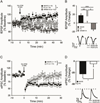Behavioral and neurophysiological evidence that lateral paracapsular GABAergic synapses in the basolateral amygdala contribute to the acquisition and extinction of fear learning
- PMID: 26593151
- PMCID: PMC4718746
- DOI: 10.1016/j.nlm.2015.11.006
Behavioral and neurophysiological evidence that lateral paracapsular GABAergic synapses in the basolateral amygdala contribute to the acquisition and extinction of fear learning
Abstract
The lateral/basolateral amygdala (BLA) is crucial to the acquisition and extinction of Pavlovian fear conditioning, and synaptic plasticity in this region is considered to be a neural correlate of learned fear. We recently reported that activation of BLA β3-adrenoreceptors (β3-ARs) selectively enhances lateral paracapsular (LPC) feed-forward GABAergic inhibition onto BLA pyramidal neurons, and that intra-BLA infusion of a β3-AR agonist reduces measures of unconditioned anxiety-like behavior. Here, we utilized a combination of behavioral and electrophysiological approaches to characterize the role of BLA LPCs in the acquisition of fear and extinction learning in adult male Long-Evans rats. We report that intra-BLA microinjection of β3-AR agonists (BRL37344 or SR58611A, 1μg/0.5μL/side) prior to training fear conditioning or extinction blocks the expression of these behaviors 24h later. Furthermore,ex vivo low-frequency stimulation of the external capsule (LFS; 1Hz, 15min), which engages LPC synapses, induces LTP of BLA fEPSPs, while application of a β3-AR agonist (SR58611A, 5μM) induces LTD of fEPSPs when combined with LFS. Interestingly, fEPSP LTP is not observed in recordings from fear conditioned animals, suggesting that fear learning may engage the same mechanisms that induce synaptic plasticity at this input. In support of this, we find that LFS produces LTD of inhibitory postsynaptic currents (iLTD) at LPC GABAergic synapses, and that this effect is also absent following fear conditioning. Taken together, these data provide preliminary evidence that modulation of LPC GABAergic synapses can influence the acquisition and extinction of fear learning and related synaptic plasticity in the BLA.
Keywords: Fear-potentiated startle; Inhibitory plasticity; Noradrenaline.
Copyright © 2015 Elsevier Inc. All rights reserved.
Figures



Similar articles
-
Fear conditioning selectively disrupts noradrenergic facilitation of GABAergic inhibition in the basolateral amygdala.Neuropharmacology. 2017 Feb;113(Pt A):231-240. doi: 10.1016/j.neuropharm.2016.10.003. Epub 2016 Oct 5. Neuropharmacology. 2017. PMID: 27720769 Free PMC article.
-
GABAergic Synapses at the Axon Initial Segment of Basolateral Amygdala Projection Neurons Modulate Fear Extinction.Neuropsychopharmacology. 2017 Jan;42(2):473-484. doi: 10.1038/npp.2016.205. Epub 2016 Sep 16. Neuropsychopharmacology. 2017. PMID: 27634356 Free PMC article.
-
Perturbation of GABAergic Synapses at the Axon Initial Segment of Basolateral Amygdala Induces Trans-regional Metaplasticity at the Medial Prefrontal Cortex.Cereb Cortex. 2018 Jan 1;28(1):395-410. doi: 10.1093/cercor/bhx300. Cereb Cortex. 2018. PMID: 29136108
-
The role of the basolateral amygdala and infralimbic cortex in (re)learning extinction.Psychopharmacology (Berl). 2019 Jan;236(1):303-312. doi: 10.1007/s00213-018-4957-x. Epub 2018 Jun 30. Psychopharmacology (Berl). 2019. PMID: 29959461 Review.
-
The role of basal forebrain cholinergic neurons in fear and extinction memory.Neurobiol Learn Mem. 2016 Sep;133:39-52. doi: 10.1016/j.nlm.2016.06.001. Epub 2016 Jun 2. Neurobiol Learn Mem. 2016. PMID: 27264248 Free PMC article. Review.
Cited by
-
Amygdala intercalated cells form an evolutionarily conserved system orchestrating brain networks.Nat Neurosci. 2025 Feb;28(2):234-247. doi: 10.1038/s41593-024-01836-8. Epub 2024 Dec 13. Nat Neurosci. 2025. PMID: 39672964 Free PMC article. Review.
-
Mechanisms of alcohol influence on fear conditioning: a computational model.bioRxiv [Preprint]. 2024 Jan 1:2023.12.30.573310. doi: 10.1101/2023.12.30.573310. bioRxiv. 2024. Update in: Alcohol Clin Exp Res (Hoboken). 2025 Jun;49(6):1233-1247. doi: 10.1111/acer.70071. PMID: 38260700 Free PMC article. Updated. Preprint.
-
Unrelenting Fear Under Stress: Neural Circuits and Mechanisms for the Immediate Extinction Deficit.Front Syst Neurosci. 2022 Apr 19;16:888461. doi: 10.3389/fnsys.2022.888461. eCollection 2022. Front Syst Neurosci. 2022. PMID: 35520882 Free PMC article. Review.
-
Lethal Interactions of neuronal networks in epilepsy mediated by both synaptic and volume transmission indicate approaches to prevention.Prog Neurobiol. 2025 Jun;249:102770. doi: 10.1016/j.pneurobio.2025.102770. Epub 2025 Apr 19. Prog Neurobiol. 2025. PMID: 40258456 Review.
-
Maturation of amygdala inputs regulate shifts in social and fear behaviors: A substrate for developmental effects of stress.Neurosci Biobehav Rev. 2021 Jun;125:11-25. doi: 10.1016/j.neubiorev.2021.01.021. Epub 2021 Feb 10. Neurosci Biobehav Rev. 2021. PMID: 33581221 Free PMC article. Review.
References
-
- Bissiere S, Humeau Y, Luthi A. Dopamine gates LTP induction in lateral amygdala by suppressing feedforward inhibition. Nature neuroscience. 2003;6:587–592. - PubMed
Publication types
MeSH terms
Substances
Grants and funding
LinkOut - more resources
Full Text Sources
Other Literature Sources
Research Materials

